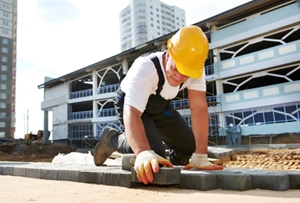Trusted Tuckpointing Services for Mending Brick and Stone Surfaces
Trusted Tuckpointing Services for Mending Brick and Stone Surfaces
Blog Article
Unlocking the Secrets of Lasting Masonry Building And Construction Practices for Eco-Friendly Buildings
Amongst the myriad approaches to green structure, sustainable masonry building and construction stands out as a reliable and resilient method that holds a wealth of untapped possibility. From the selection of materials to cutting-edge building strategies, the tricks to accomplishing sustainability within stonework building and construction are diverse and appealing.
Benefits of Sustainable Stonework Building
Accepting lasting stonework construction techniques not just lowers ecological effect however additionally offers long-lasting financial benefits to builders and neighborhoods. By utilizing products like recycled blocks, blocks, and rocks, building contractors can dramatically decrease the carbon impact of their projects while promoting source efficiency. Furthermore, lasting stonework building and construction methods, such as proper insulation and thermal mass residential or commercial properties, can enhance power performance within structures, bring about minimized functional expenses over time.
Moreover, the longevity and resilience of stonework frameworks add to lasting economic advantages. Buildings constructed using sustainable masonry techniques frequently call for much less upkeep and repair, equating to cost savings for builders and homeowner. The longevity of stonework products also makes certain that frameworks remain secure and secure, minimizing the demand for frequent renovations or replacements.
Eco-Friendly Masonry Products
Utilizing green stonework materials is a critical action towards enhancing the sustainability of building and construction methods and lessening ecological effect while optimizing lasting financial benefits. Lasting stonework materials are sourced, generated, and utilized in a fashion that minimizes overall ecological effect. Sustainable concrete obstructs incorporate recycled accumulations and might feature enhanced insulation buildings, contributing to power efficiency in structures.
Furthermore, all-natural materials like adobe, rammed earth, and straw bundles provide excellent thermal mass homes, reducing the demand for heating and cooling power. These materials are typically locally offered, advertising regional economies and minimizing transportation-related carbon emissions. By choosing eco-friendly masonry materials, building and construction projects can dramatically decrease their ecological impact and add to the production of healthier, much more sustainable developed settings.
Energy-Efficient Masonry Strategies
Energy effectiveness plays a critical function in enhancing the sustainability of stonework building methods. By executing energy-efficient masonry techniques, building contractors can significantly minimize the general energy usage of a structure, bring about lower functional prices and a smaller ecological footprint. One essential energy-efficient stonework technique is making use of thermal mass, which entails integrating dense materials like concrete or block right into the structure's framework to absorb and keep heat. This aids manage interior temperatures, decreasing the need for mechanical home heating and cooling down systems.

Developments in Lasting Masonry
Current advancements in lasting masonry techniques have caused cutting-edge strategies that are improving the construction sector. One such development is the growth of self-healing concrete, which makes use of microorganisms embedded within the concrete to heal cracks autonomously. This innovation not just lowers maintenance expenses but also boosts the sturdiness of stonework structures, adding to their sustainability.
An additional noteworthy advancement is making use of recycled accumulations in stonework building - masonry contractor. By integrating products such as smashed ceramic waste or recycled glass into concrete mixes, home builders can lower the ecological effect of building jobs while preserving structural stability. This practice not just draws away waste from landfills however additionally preserves all-natural sources, making it a key advancement in sustainable masonry construction
Furthermore, the integration of digital layout tools, such as Structure Info Modeling (BIM), is reinventing the means masonry structures are intended and built. BIM enables even more specific calculations, decreased material wastage, and improved energy efficiency, eventually resulting in even more lasting building practices. These developments collectively signify an appealing future for sustainable masonry building in the age of environment-friendly buildings.
Future Trends in Stonework Sustainability
With the cutting-edge strides made in lasting masonry practices, the future patterns in stonework sustainability are positioned to more transform the building sector. One of the essential patterns shaping the future of masonry sustainability is the increased integration of technology. Developments such as Structure Details Modeling (BIM) and online fact simulations are being used to optimize stonework building processes, bring about lowered material waste and improved energy effectiveness in buildings.
Additionally, the development of novel lasting products is set to play a significant role in improving the eco-friendliness of stonework construction. masonry contractor. Innovations like self-healing concrete, recycled aggregates, and bio-based binders are getting grip for their capacity to reduce ecological impact while keeping architectural honesty

Conclusion
In conclusion, lasting masonry construction methods use numerous advantages for environmentally friendly buildings. masonry contractor. Innovations in lasting masonry are constantly being created to additionally improve the environmental performance of structures.
Report this page